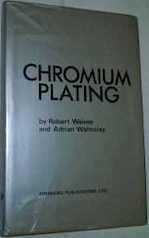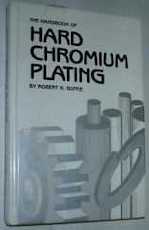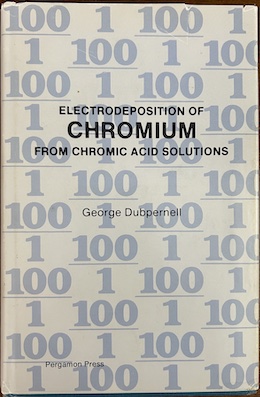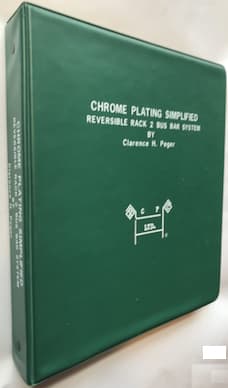
-----
Replating chrome onto existing chrome
There are two general types/applications of chrome plating:
• Decorative chrome, which is actually a very thin plating of chrome over a relatively thick layer of nickel plating, and
• Hard chrome, which is very heavy chrome plating for wear resistance and oil retention.
Please see our Intro to Chrome Plating if interested.
While decorative chrome would almost always be stripped and redone, it is common to try to save the old hard chrome when replating.
Q. we need to do replating of hard chrome on chrome plated components (rods) which are already post polished and ground.
Dheeraj Singh- Maharashtra India
December 18, 2024
A. Mr. Singh,
Re-chrome process
Strip the chrome using caustic soda solution with reverse current maintain temperature 90-100F After chrome strip rise the parts then direct current to nickel activator short time follow up to dip the parts into chrome predip then chrome plate.

Popatbhai B. Patel
electroplating consultant - Roseville, Michigan
February 20, 2025
⇩ Related postings, oldest first ⇩
Acronyms:
HEEF 25 = a proprietary chrome plating process, "High Efficiency Etch-Free"
Q. I was after some feedback on how to plate hard chrome plating over existing chrome in a HEEF 25 type solution. We have tried a few different ways and none seem to be giving us consistent enough results to keep persisting with them. The plate seems to cover about 90% of the job beautifully but a few small areas blister or flake. We know of other people who consistently obtain perfect results. Our suppliers seem to know very little about the product in terms of procedures that need to be followed to obtain good results.
I would greatly appreciate any suggestion.
Regards,
John AdamsPlating shop - Melbourne, Victoria, Australia
2004
|
|
RECOMMENDED CHROME PLATING BOOKS
for Shops, Specifiers, & Engineers  by Weiner & Walmsley (1980) avail from eBay, AbeBooks, or Amazon  by Robert K. Guffie (1986) avail from AbeBooks, or Amazon  avail from eBay, AbeBooks, or Amazon "Hard chromium plating: A Handbook of Modern Practice" by John David Greenwood (1971) avail from eBay  very rarely avail from Amazon but copies are available in a few libraries) "A Chromium Plating Bath With The Fluoride Ion" by Alfred Perlenfein (2013) avail from eBay, AbeBooks (as an Amazon Associate & eBay Partner, we earn from qualifying purchases) A. Mr. Adams, One of my clients is plating hard chrome over hard chrome in HEEF 25 type of process whenever he doesn't get required thickness in an automated line. If you are not stripping chrome Please follow the steps below. 1. Give good pretreatment prior treatment. 2. Pass low current for about 15 minutes i.e around 25 % of the total current you generally pass. 3. After the above step plate the substrate to the required thickness, but pass around 20 % less current density than your regular current density and give more time. The above steps should help you in getting good plating as my client is already getting. N.K.Praveen Kumar- Secunderabad, India A. You probably need to go to tech services at the manufacturer for the best information. You need to be careful with the caustic clean and the acid etch as it is easy to mess up the surface. We used to use a short reverse in the plating tank followed by a voltage ramp up to the final voltage/amperage. If the part has any considerable size, are you letting it come to temp before starting. What temp are you using? Tank anode or conforming? James Watts- Navarre, Florida A. I don't have anything specific to HEEF, but this should work: 1. Soak clean to remove any grease, oil, etc. Rinse. 2. Reverse current in chrome 1 to 2 minutes about 6 volts. 3. Direct current starting at zero volts, then ramp up to full plating current over about 5 minutes.  Jeffrey Holmes, CEF Spartanburg, South Carolina |
A. John. You cannot do the etching in HEEF 25 solution, but if you have a regular hard chrome plating solution you can do the etching in that solution. Etch for two minutes, don't rinse the area when you move the part from the tank to tank. Let the part take the solution temperature with no current, raise the current to 0,5 A / dm2 for 5 minutes, raise the current once again to 2,5 A/dm2 for 5 minutes. Look at bubbles in the chrome solution they will be a little bigger than when you chrome with right current. Raise the current very slow to the plating current. All activation steps: read Mr Watts suggestion.
Regards

Anders Sundman
4th Generation Surface Engineering
Consultant - Arvika,
Sweden
![]() Thank you to everyone for your responses. I have gotten in contact with tech advisors in U.S and they have faxed me appropriate information very similar to the responses posted. I greatly appreciate your time and efforts to make response. So far the jobs we have tried are working out well. Thanking you again.
Thank you to everyone for your responses. I have gotten in contact with tech advisors in U.S and they have faxed me appropriate information very similar to the responses posted. I greatly appreciate your time and efforts to make response. So far the jobs we have tried are working out well. Thanking you again.
Plating shop - Melbourne, Victoria, Australia
Multiple threads merged: please forgive chronology errors and repetition 🙂
Q. Sir,
If chrome plated parts are undersize in grinding then is it possible to replate chrome instead of deplating & then plating?
- India
June 27, 2013
A. If the company that you are doing this work for will allow it, THEN it is a possibility.
A number of chrome platers have very poor luck at this.
The part needs to be water break clean and allowed to get to tank temp before plating. The chrome may etch at an unknown rate depending on time and chemical concentrations. A short low voltage reverse in the plating tank normally would be done for an etch.
Some people swear by a high voltage flash for one minute to start it plating. Other platers rapidly ramp the voltage up until it reaches about 10% of the final amperage and then slowly ramp it up to final required amperage.
Many if not most companies will not let you do this.
We found that we had an adhesion problem if we chemical stripped it to bare metal. We would send the part to grinding for a kiss pass and it would plate just fine.
- Navarre, Florida
![]() Thanks for suggestion on my query of chrome over chrome.
Thanks for suggestion on my query of chrome over chrome.
I have followed steps & found good result. There is no pull off of plating after grinding.
You have sorted out my major rework problem.
Also I want to know about adhesion testing of plating.
- Maharashtra, Kolhapur, India
Ed. note: Hi Dhanajay. Please search the site for 'adhesion test chrome', and post your followup questions on one of those threads so this thread can remain being about chrome on chrome. Thanks.
Multiple threads merged: please forgive chronology errors and repetition 🙂
Q. Recently we machined chrome plated shaft ID beyond allowable limits. Can anyone advise me how to chrome plate over chrome without any failure.
Regards
G G
- ABU DHABI HARARE
October 7, 2015
A. Sir
It is possible to plate Hard Chrome over Hsrc Chrome provided the initial coating is more than 100 microns. The job to be plated must be polished using fine abrasive media around 320G-400G then followed by normal pretreatment process and Reverse etching in the plating tank for about 2-3 minutes at around 1-1.5 amps/inch square.
Start plating at 2 V; gradually raise in Voltage of 2 amps every 4-5 minutes until the required current density is attained. Please be sure all anodes are working, and gassing is observed on all these anode while reverse etching. Good luck.
mahendra gargattiGargatti Electroulocs - BELGAUM.KARNATAKA INDIA
Ed. note: Sorry, we don't know what "Hsrc" means or whether it is a typo.
Q, A, or Comment on THIS thread -or- Start a NEW Thread
